Remove the battery (A) and battery tray.
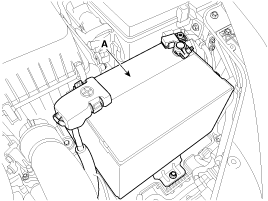
Use fender covers to avoid damaging painted surfaces.
To avoid damage, unplug the wiring connectors carefully while holding the connector portion.
Mark all wiring and hoses to avoid misconnection.
Disconnect the battery terminals.
Remove the battery (A) and battery tray.

Remove the battery extention connector (A).
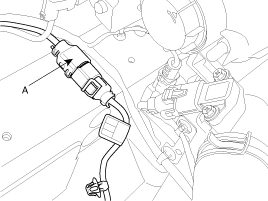
Remove the engine cover.
Remove the under cover.
Drain the engine coolant. Remove the radiator cap to speed draining.
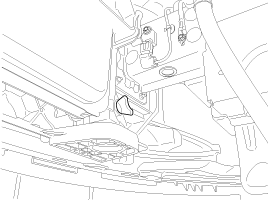
Remove the radiator grill upper cover (A) and the air duct (B).
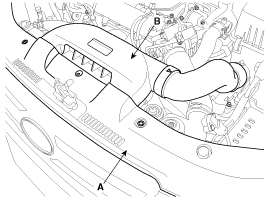
Remove the intercooler hoses (A).
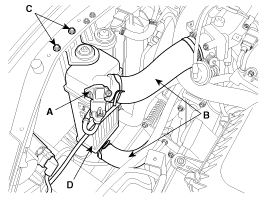
Using a plier, take off the cap. After it removed, there will be another (-) cap which you can use a (-) driver.
Remove the air cleaner assembly.
Disconnect the AFS (Air Flow Sensor) connector (A).
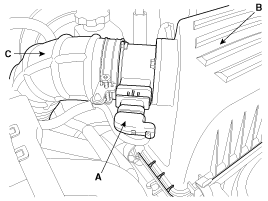
Remove the air cleaner upper cover (B).
Remove the air hose (C).
Remove the air cleaner element.
Disconnect the PCM connectors and remove the air cleaner lower part.
Remove the wiring (A) from fuse box.
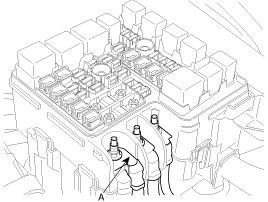
Remove the ground cable from transaxle. (Refer to Transaxle in MT Group)
Remove the coolant reservoir tank hose (A).
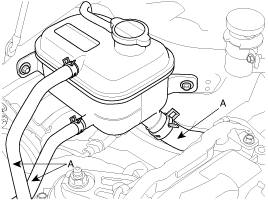
Remove the radiator upper hose (A).
Remove the radiator lower hose (B).
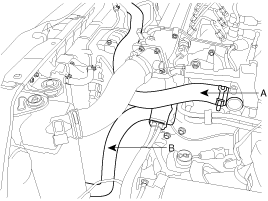
Remove the fuel hose. (Refer to Fuel pump in FL Group).
Remove the brake vacuum hose (A).
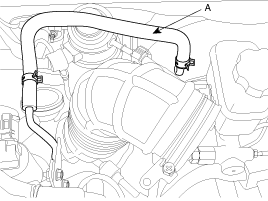
Remove the engine room junction box harness connectors (A) and the ground lines.
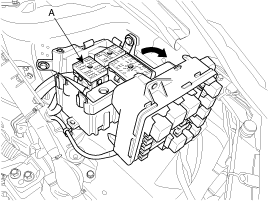
Remove the heater hoses (A).
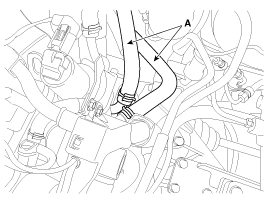
Remove the transaxle wire harness connectors and control cable from transaxle. (Refer to Transaxle in MT Group)
Remove the clutch release cylinder.
Remove the transaxle control cable.
Install the SST(09200-38001, 09200-1C000), the engine support fixture and the adapter, on the engine and transaxle assembly.
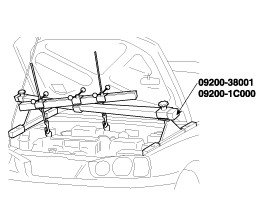
Remove the engine mounting support bracket (A).
Tightening torque :
Nut (D) :
68.6 ~ 93.2N.m (6.5 ~ 8.5kgf.m, 50.6 ~ 68.7lb-ft)
Bolt (B), Nut (C) :
49.0 ~ 63.7N.m (5.0 ~ 6.5kgf.m, 36.2 ~ 47.0lb-ft)
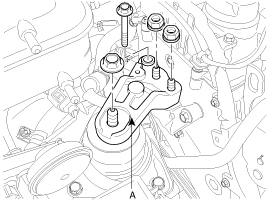
Remove the transaxle mounting bracket. (Refer to Transaxle MT or AT Groups)
Tightening torque :
Bolt (B) :
88.3 ~ 107.9N.m (9.0 ~ 11.0kgf.m, 65.1 ~ 79.6lb-ft)
Remove the front tires.
Remove the drive shaft lock pin and the lock nut with washer. (Refer to Front axle in DS Group)
Remove the lower arm ball joint mounting, the stabiliwer bar link mounting and the steering tie rod mounting. (Refer to Front suspension system in SS Group)
Remove the steering u-joint mounting bolt. (Refer to Steering in ST Group).
Remove the front muffler (A).
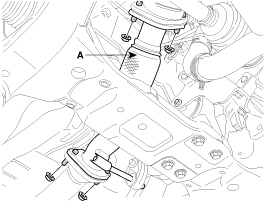
Using a floor jack, support the engine and transaxle assembly.
After removing the sub frame mounting bolt , the engine and transaxle assembly may fall downward, and so support them securely with floor jack.
Verify that the hoses and connectors are disconnected before removing the engine and transaxle assembly.
Remove the sub frame bolts and nuts.
Tightening torque :
Bolt (A) : 44.1 ~ 53.9N.m (4.5 ~ 5.5kgf.m, 32.5 ~ 39.8lb-ft)
Nut (B), Bolt (C) : 156.9 ~ 176.5N.m (16.0 ~ 18.0kgf.m, 115.7 ~ 130.2lb-ft)

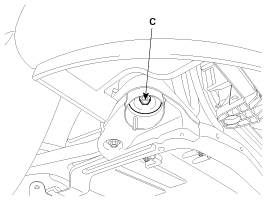
Remove the engine support fixture and the adapter.
Remove the engine and transaxle assembly by lifting vehicle.
When remove the engine and transaxle assembly, be careful not to damage any surrounding parts or body components.
Installation is in the reverse order of removal.
Perform the followings :
Adjust shift cable.
Adjust throttle cable.
Refill engine with engine oil.
Refill transaxle with fluid.
Refill radiator and reservoir tank with engine coolant.
Place heater control knob on "HOT" positon.
Bleed air from the cooling system
- Start engine and let it run until it warms up. (until the radiator fan operates 3 or 4 times.) - Turn Off the engine. Check the level in the radiator, add coolant if needed. This will allow trapped air to be removed from the cooling system. - Put radiator cap on tightly, then run the engine again and check for leaks. |
Clean battery posts and cable terminals with sandpaper assemble them, then apply grease to prevent corrosion.
Inspect for fuel leakage.
- After assemble the fuel line, turn on the ignition switch (do not operate the starter) so that the fuel pump runs for approximately two seconds and fuel line pressurizes. - Repeat this operation two or three times, then check for fuel leakage at any point in the fuel line. |